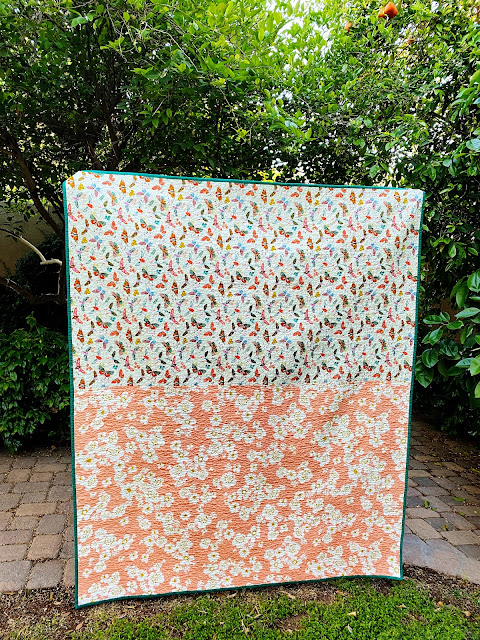Monday, April 15, 2024
aunt bet’s mother’s day, a finish
Saturday, April 13, 2024
liberty courthouse steps, a start
Thursday, April 11, 2024
low-volume crossroads, a finish
binding is a grey stripe, a riley blake basic.
however, as i worked under the quilt over the course of several binding sessions and snuggled under it in between, i began to feel differently. i thoroughly enjoy this light-hearted, light-colored quilt and think the various blocks work together great. there are so many prints i love and i'm happy they're all in there.
this quilt was once again an exercise in the very difficult task of quilitng straight lines. golly, it's hard! any little deviation or variance feels so noticeable. washing the quilt and the resulting crinkle has helped hide the flaws somewhat, but not entirely. oh, well. i don't focus on them much and forget to look at them at all the more i use the quilt. perhaps using pink thread makes them more obvious, but i do like it.
my book pairing for this quilt - milly molly mandy, the sweetest childhood stories ever told. milly molly mandy's pink striped outfits perfectly echo the pink centers of these blocks.
Tuesday, April 9, 2024
melonaide brightside, a finish
the top consists of 21 solids in citrus and melon colors, which is why i named it "melonaide." i haven't talked about or shown this one much, so i've had some instagram friends surprised at what they consider a departure from my norm. i haven't worked in solids for a while since my stella grande quilts were complete, but i definitely do work in solids, so i think it's still part of my regular repertoire.
i haven't talked about it much because the top came together really quickly and then just sat, waiting.
i did sneak some prints in on the back, which is composed of two ruby star society prints. the peachy floral is a wide back cotton sateen (leftover from my daughter's "the pleasantest thing"). i love the silky handfeel of the sateen.
a little too much shadow in this shot, but you can see the colors popping in the lowering sunshine that is so beautiful across my yard in the later afternoon.
Saturday, April 6, 2024
weekend listening and stitching
i've continued with my batch binding progress - on quilt number three for the week!
this is the perfect weekend for me to get lots more handwork done as our family is snuggled up at home for the semiannual general conference of our church, when we get to listen at home to inspiring talks broadcast from world church leaders in five two-hour sessions spread out over saturday and sunday. (you can watch live this weekend or recorded whenever you like afterwards.) we're in between sessions two and three at the moment, so i'm making a small report on what i've accomplished this week. i'll just go in the order the photos loaded:
last night i got two rows of "wiltshire rows" put together and mostly finalized the layout for the quilt. i've been waffling on exactly how i was going to do it, but seem to have it down now. i just need a few more of the small pieces and i can get it all assembled into a flimsy.
a few nights ago this one got completed, washed, and dried. it's so good! i need to take some nice finishing photos and then i'll share all about it.
Wednesday, April 3, 2024
liberty holly hobbie, a finish
Saturday, March 30, 2024
mildred and ethel, a finish
after nearly 5 years, mostly due to extensive handwork, "mildred and ethel" is done.
Wednesday, March 27, 2024
wiltshire rows, a start
on sunday, i was reminded that a friend, neighbor, and church family member of 21 years will soon be moving, and i realized i want to give her a sunday liberty lap quilt to take with her. i thought about those i am completing and neither seemed right, so it'll need to be a new one.






















































